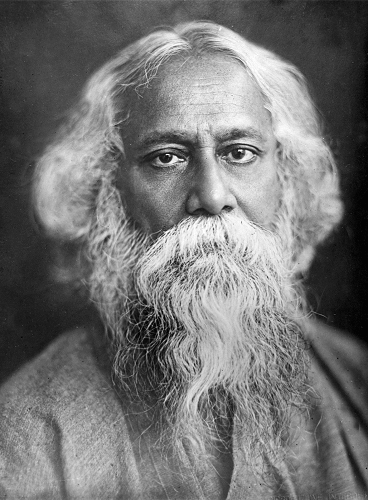Where the Mind Is Without Fear: Summary & AnalysisAbout the Poet
During the late 19th and early 20th centuries, Rabindranath Tagore influenced Bengali music and Indian art. His collection of rhymes and songs, Gitanjali or The Song Offerings, earned him the Nobel Prize in Literature in 1913, making him the first non-European to do so. Tagore popularized the use of informal language in Bengali literature and developed new poetic forms. Bengali literature was liberated from traditional patterns based on classical Sanskrit. The greatest of Indian culture was also brought to the West largely by Tagore, who is also often recognized as the most remarkable modern artist on the Indian subcontinent. He was a Pirali Brahmin from Kolkata, and his family had moved here from Jessore, where they had ancestors who were members of the aristocracy. At the age of 8, Tagore began penning poems. At age 16, he published his first lengthy poems under the alias Bh?nusi?ha (which means "SwerewereLion"), which literary experts believed to be forgotten classics. By 1877, he had begun to write his first short stories and plays under his name. He criticized the Raj and pushed for independence from Britain as a passionate patriot and humanist. He created significant work representing the Bengal Renaissance, including paintings, drawings, sketches, hundreds of writings, and almost 2,000 songs. Visva-Bharati University, which he created, is another institution that carries on his legacy. His books, short tales, songs, dance plays, and other works address political and personal problems. His most well-known compositions are Ghare-Baire (meaning "The Home and the World"), Gitanjali (meaning "Song Offerings"), and Gora (meaning "Fair-Faced"). He is well regarded for his poetic works, realism, and unnatural reflection in his writings. His songs were chosen as the national anthems of two countries: Bangladesh's Amar Shonar Bangla and India's Jana Gana Mana. Tagore also wrote and tuned the National Anthem of Sri Lanka's original song. When the Jallianwala Bagh massacre occurred in 1919, Tagore renounced the knighthood he received in 1915 from the British Crown. Tagore began painting and drawing when he was sixty. His numerous pieces were successfully shown all around Europe after their opening in Paris. Red and green were probably the only colors he couldn't see, so his artwork often had odd color combinations and unconventional aesthetics. His manuscripts' scribbles, cross-outs, and word arrangements displayed his creative handwriting through straightforward visual leitmotifs. About the PoemThe poem "Where The Mind is Without Fear" by Rabindranath Tagore is translated into English. Chitto Jetta bhoyshunyo was its original Bengali name. The Bengali poem was published in 1910 as a part of Tagore's Gitanjali: a collection of poems. Tagore created this English translation when translating some of his work into English at William Rothenstein's request in 1911. The English Gitanjali, which was published by the Indian Society of London in 1912, had it as a poem No.35. At a meeting of the Indian National Congress in Calcutta in 1917, Tagore read aloud the English translation, which was then known as "Indian Prayer."The poem often appears in textbooks. Chitto Jetha Bhoyshunyo is also popular among liberals in Bangladesh. 
In a speech to the Indian Parliament in New Delhi in 2010, President Obama used the first two sentences of the English translation. Summary of the poem: Where the Mind Is Without FearThe poem consists of 11 lines in total. These lines are not divided into stanzas. They are divided into meaningful purposes of the story to make the poem easier to follow and understand. The poet begins with these words to see the idealized vision of his home country. He said no one in his country should ever live in constant Fear. Instead, they should be bold and confident in themselves. Knowledge should be available to all citizens. That is, educational institutes should allow students of all races and classes. All the regions of India and their people should unite rather than fight for power and authority. They must fight together against common enemies to prevent a common fate. In these lines, the poet encourages everyone always to speak the truth no matter the situation. Nobody should use deception to their advantage when striving to better themselves and keep trying until they attain a state of self-perfection. He then imagines why it is a water stream not soiled that can easily and quickly pass through without too many obstacles. On the other hand, he imagines the habit of being a desert. He believes that the stream of reason is lost in the sand of habit. It means that he is saying that the people of his country do not think about their current superstitions, and he wants them to question these beliefs by logic. In these words, the poet talks directly to God. He wants his fellow citizens to be guided by him so that they can broaden their view of their thoughts and actions. If they did, India would be transformed into a heaven where all its citizens would be free. Analysis of the PoemThe poem's first line, part of the title, holds significant meaning. "Where the mind is without fear, and the head is held high" 'Fear' in this line refers to the Fear inculcated in the minds of Indians under British rule. Here, the poet speaks of the miserable life of the people dominated by the British. The poet sees India as a country where people's minds are free from Fear and live dignified lives. He also wanted to communicate that freedom could be achieved when the mind was fearless and the head was respected and held high. The poet also argues in the line "Where knowledge is free" that achieving independence will allow people to learn and become independent, which was restricted under British rule. "Where the world has not been broken up into fragments "Where words come out from the depth of truth" implies that the poet wanted the people in his nation to live with complete and honest intent. "Where tireless striving stretches its arms towards perfection", Here, the term "tireless striving" has been personified. According to the poet, everyone should strive for perfection, or the status of an ideal country, and after all those years of struggle, they would finally reach their goal of attaining freedom and perfection. "Where the clear stream of reason has not lost its way The poet refers to reason and habit using metaphors. He describes reason as a 'clear stream' that is unpolluted and pure. In this passage, he discusses how people's ideas should be unclouded, honorable, honest, and free of corruption. The line "dreary desert sand of dead habit" also refers to societal evils like irrational customs that defy logic and reason. In the last three lines, the poet asks the Almighty to guide and support him in his quest for independence. The poet wanted his fellow citizens to be encouraged by their noble thoughts and actions. He referred to freedom as heaven and God as the Father, asking him to awaken His people and help them reach this glorious place.
Next TopicWings of Fire Summary by Abdul Kalam
|
 For Videos Join Our Youtube Channel: Join Now
For Videos Join Our Youtube Channel: Join Now
Feedback
- Send your Feedback to [email protected]
Help Others, Please Share









